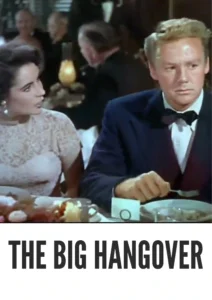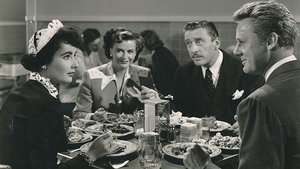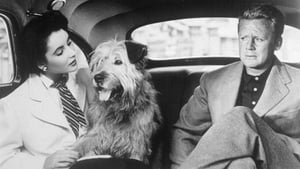Contact: info@alwanfilm.com
Video Sources 0 Views
- The Big Hangover 1950 Colorized


Synopsis
Table of Contents
ToggleThe Big Hangover 1950 Colorized Review: A Light-Hearted Comedy with a Twist

Introduction
In the landscape of post-World War II Hollywood, The Big Hangover (1950) stands out as a unique, light-hearted comedy that combines elements of romance, satire, and an absurd twist of psychological effects. Directed by Norman Krasna and starring the charming duo of Van Johnson and Elizabeth Taylor, the film presents a curious and unexpected take on mental and physical trauma experienced by returning war veterans. With its original screenplay, sharp dialogue, and charismatic performances, The Big Hangover offers more than just laughs; it provides an amusing yet insightful commentary on societal expectations, personal anxieties, and the pursuit of normalcy in post-war America.
In this review, we will explore The Big Hangover (1950) by delving into its plot, performances, and directorial vision. We will also analyze its place in film history, focusing on its comedic tone and thematic relevance, while considering how it was received by critics and audiences of its time.
Check The Full Colorized Movies List
Check Our Colorized Movies Trailer Channel
Understanding The Big Hangover 1950 Colorized: Director, Cast, and Genre
Director’s Vision
Norman Krasna, a writer and director known for his sharp wit and lighthearted approach to serious subjects, brings his unique flair to The Big Hangover. Krasna was no stranger to romantic comedies, having penned several successful films, including Bachelor Mother (1939) and The Devil and Miss Jones (1941). His experience with blending humor and romance is evident in The Big Hangover, which finds its humor in absurd situations while also touching on the complexities of post-war life.
Krasna’s directorial vision for The Big Hangover was clearly aimed at creating a feel-good comedy with a heart, using the peculiar condition of its protagonist as a vehicle for humorous misunderstandings and personal growth. While the film never delves too deeply into the darker aspects of trauma, Krasna’s deft hand ensures that the story remains lively and engaging without losing its sense of humor.
The Iconic Performances of the Cast
The film’s success is anchored by the delightful performances of its two leads: Van Johnson and Elizabeth Taylor. Van Johnson plays the role of David Maldon, a law student with a peculiar post-traumatic reaction to alcohol, which causes him to experience severe hangover-like symptoms without ever taking a drink. Johnson, known for his easygoing charm and all-American good looks, brings a warmth and comedic energy to the role, portraying David as a lovable and slightly bewildered character caught in a series of misadventures.
Opposite Johnson is the radiant Elizabeth Taylor, who, at just 18 years old, plays Mary Belney, the daughter of David’s law firm boss. Taylor, already a rising star by 1950, brings her characteristic beauty and poise to the role, but also demonstrates her comedic timing and ability to play against type as the romantic interest in a screwball comedy. Her chemistry with Johnson is effortless, and together, they create a dynamic that keeps the film engaging from start to finish.
Exploring the Genre
The Big Hangover is a romantic comedy at its core, but it also incorporates elements of farce and social satire. Set against the backdrop of post-war America, the film uses humor to explore the anxieties and pressures faced by individuals trying to reintegrate into civilian life. The film’s absurd premise—David’s allergic reaction to alcohol—provides ample opportunity for physical comedy and misunderstandings, making it a perfect example of the screwball comedy genre that was popular in the 1930s and 1940s.
What sets The Big Hangover apart from other romantic comedies of its time is its willingness to play with the absurd while still maintaining a sense of emotional sincerity. The film strikes a delicate balance between humor and heart, offering a story that is both entertaining and thought-provoking in its exploration of post-war life and personal identity.
Exploring the World of The Big Hangover: Plot and Characters
Detailed Synopsis
The Big Hangover (1950) centers around David Maldon (Van Johnson), a young law student and World War II veteran who is working for a prestigious law firm while completing his studies. Despite his bright future, David has one peculiar problem: he suffers from a rare psychological condition where even the slightest exposure to alcohol triggers the symptoms of a massive hangover, despite him never actually drinking. This bizarre affliction is the result of his wartime trauma, during which he nearly drowned in a vat of sake while stationed in Japan.
The plot takes off when David’s boss, John Belney (played by Percy Waram), invites him to a formal dinner at his home. Unbeknownst to David, the evening’s festivities include plenty of wine, and his condition is quickly triggered, leading to a series of comic mishaps. During the dinner, David meets Belney’s daughter, Mary (Elizabeth Taylor), who quickly becomes smitten with the charming and slightly hapless law student.
As David tries to navigate his budding romance with Mary, he is also confronted with mounting pressure at the law firm, where he is tasked with helping to defend a wealthy client involved in a scandalous legal case. The absurdity of his situation intensifies as his condition continues to wreak havoc on his professional and personal life, leading to a series of misunderstandings and comedic situations.
Throughout the film, David’s strange affliction serves as both a source of humor and a metaphor for the lingering effects of war trauma. His inability to “fit in” with the normal expectations of society mirrors the struggles faced by many returning veterans, though the film keeps the tone light and playful, ensuring that the comedy remains front and center.
The Complex Protagonist and Memorable Supporting Characters
David Maldon is a complex protagonist, both likable and sympathetic in his struggles. Van Johnson’s portrayal of David adds depth to the character, turning what could have been a one-dimensional role into something more nuanced. David’s quirky condition makes him an outsider in his own world, but his determination to succeed and find love despite his setbacks makes him a relatable and endearing character.
The supporting cast adds to the film’s charm, particularly Percy Waram as John Belney, the stern yet compassionate boss, and Leon Ames, who plays David’s mentor at the law firm. Their interactions with David provide many of the film’s comedic moments, particularly when they unknowingly exacerbate his condition.
The Art of Comedy in The Big Hangover 1950 Colorized
Understanding the Use of Absurdity
One of the most striking aspects of The Big Hangover is how it uses absurdity as a driving force for both its humor and its narrative. David’s condition is inherently ridiculous—an allergic reaction to alcohol without consumption—and yet it serves as a perfect device for exploring the pressures of conformity and societal expectations. The absurdity of David’s plight creates countless opportunities for physical comedy, from his stumbling through drunken dinner parties to his exaggerated reactions to even the smell of alcohol.
Krasna’s direction ensures that the humor remains light and playful, never venturing into mean-spirited territory. The film’s absurd moments are balanced with moments of genuine emotional sincerity, making it more than just a slapstick comedy. This combination of humor and heart is what makes The Big Hangover stand out from other films in the genre.
Development of Farcical Elements
The film’s farcical elements are built around David’s escalating misadventures. As he tries to maintain his composure in high-stress situations—whether in the courtroom or at social gatherings—his affliction consistently undermines his efforts, leading to increasingly ridiculous scenarios. These farcical elements are reminiscent of classic screwball comedies, where misunderstandings and mistaken identities lead to a cascade of comedic events.
However, unlike many screwball comedies, The Big Hangover grounds its farce in a real-world concern: the difficulty of returning to normal life after experiencing trauma. While the film’s tone is always lighthearted, there is an underlying commentary on the pressures faced by veterans and the expectations placed upon them to quickly adapt to civilian life.
Thematic Exploration in The Big Hangover 1950 Colorized
Trauma and Identity
At its core, The Big Hangover is a film about identity and the ways in which individuals cope with personal trauma. David’s condition serves as a metaphor for the lingering effects of war and the difficulty many veterans face in reintegrating into society. While the film never addresses these themes explicitly, they are woven into the fabric of the story, giving it a deeper layer of meaning beyond its comedic surface.
The film also explores themes of personal integrity and societal pressure. David’s struggles to fit in with the upper-crust world of law and socializing mirror the challenges faced by many individuals who feel out of place in environments that demand conformity. His journey is one of self-acceptance, as he learns to navigate his unique challenges while still pursuing his goals.
Reception and Controversy Surrounding The Big Hangover 1950 Colorized
Initial Reviews and Audience Reactions
Upon its release in 1950, The Big Hangover received mixed reviews from critics. While many praised the performances of Van Johnson and Elizabeth Taylor, some critics felt that the film’s premise was too far-fetched and lacked the depth of other post-war comedies. However, audiences largely embraced the film, enjoying its lighthearted tone and the chemistry between the two leads.
Critics who appreciated the film often highlighted Krasna’s witty screenplay and the film’s unique take on post-war anxieties. The comedic portrayal of David’s condition was seen as a clever way to address deeper issues without becoming overly serious or heavy-handed.
Controversy Over the Film’s Treatment of Trauma
While the film was generally well-received, some contemporary audiences and critics questioned its use of trauma as a comedic device. In an era when many films were dealing more directly with the psychological effects of war, The Big Hangover was seen by some as trivializing a serious issue. However, others defended the film, arguing that its lighthearted approach was a refreshing change from the more somber tone of many post-war dramas.
Where to Watch The Big Hangover 1950 Colorized Online
For those interested in experiencing The Big Hangover (1950), the film is available on several streaming platforms, including Amazon Prime Video and Turner Classic Movies. Additionally, DVD and Blu-ray versions of the film are available for purchase, making it accessible to modern audiences who want to explore this hidden gem of 1950s cinema.
FAQs About The Big Hangover 1950 Colorized
Q: What is the premise of The Big Hangover?
A: The Big Hangover is a romantic comedy about a young law student, David Maldon, who suffers from an unusual psychological condition that causes him to experience hangover-like symptoms whenever he is exposed to alcohol, despite never drinking.
Q: Who stars in The Big Hangover?
A: The film stars Van Johnson as David Maldon and Elizabeth Taylor as Mary Belney, the daughter of David’s law firm boss.
Q: What themes are explored in the film?
A: The film explores themes of trauma, identity, personal integrity, and societal pressure, all within the framework of a lighthearted romantic comedy.
Q: How was The Big Hangover received by critics?
A: The film received mixed reviews upon its release, with some praising the performances and comedic elements, while others felt the premise was too far-fetched.
Conclusion
The Big Hangover (1950) is a delightful and quirky romantic comedy that stands out for its unique premise and charming performances by Van Johnson and Elizabeth Taylor. While the film’s portrayal of trauma through comedy may not have resonated with all audiences, it remains a fascinating example of post-war cinema that used humor to address deeper societal issues. Norman Krasna’s witty direction, combined with the film’s farcical elements and emotional sincerity, makes The Big Hangover a hidden gem worth rediscovering. Whether viewed for its comedic charm or its thoughtful exploration of personal identity, the film continues to offer something for modern audiences, reminding us that even the most absurd situations can carry a deeper meaning.












